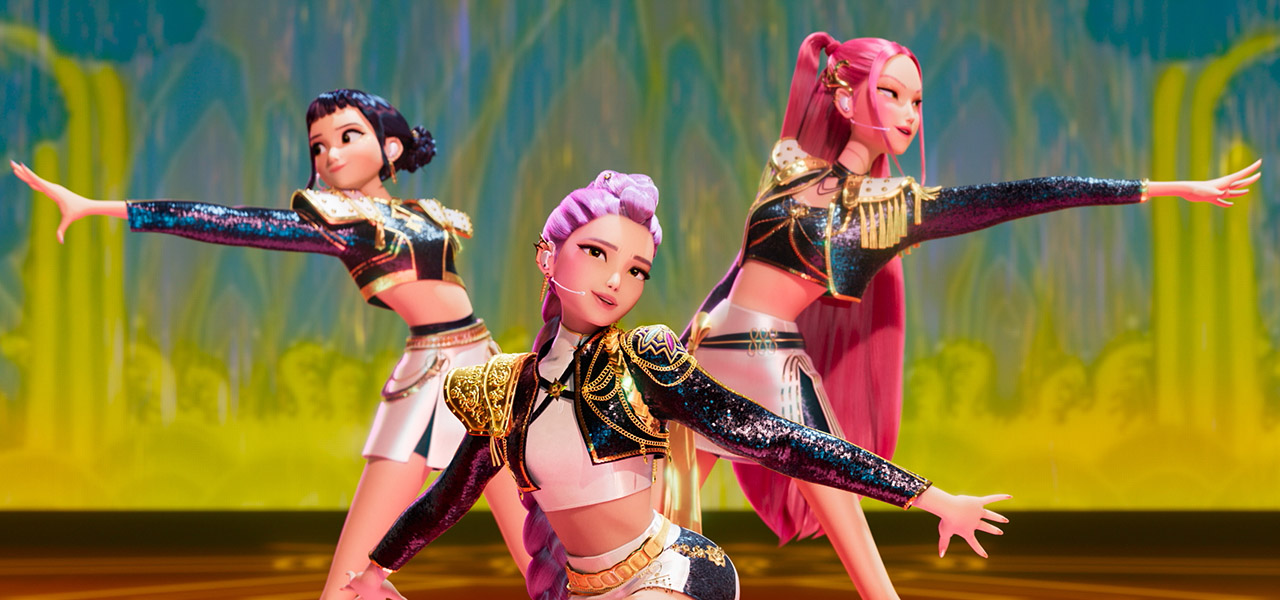

The Directors Of ‘KPop Demon Hunters’ Discuss The Unexpected Challenges Of Making An Animated K-Pop Film
Original feature animation ideas are not dead. In fact, this summer Netflix is making a home for some Sony Pictures Animation distribution orphans including KPop Demon Hunters from directors Maggie Kang and Chris Appelhans. The film debuts today on the streamer.
Animated by Sony Pictures Imageworks, the cg feature is a musical spectacle heavily influenced by the global K-pop phenomenon of glitzy, choreographed boy and girl bands, mixed with the gravitas of anime and K-drama storytelling. Featuring brand-new songs created for the film, Kang and Appelhans found themselves not just making a culturally authentic musical but also having to commission songs that were story-centric and good enough to drive the central themes of their modern day, supernatural story.
KPop Demon Hunters centers on a fictional, multi-generational war between Gwi-Ma (Byung-hun Lee), a Korean demon king, who relentlessly tries to break into the human world with his demon hordes but has been successfully thwarted over the centuries by a succession of secret female demon hunters who use their voices to keep his evil at bay. In modern times, those singers front-face as the Korean girl band, Huntrix, who are Rumi (Arden Cho), Mira (May Hong), and Zoey (Ji-young Yoo). To fight fire with fire, Gwi-Ma allows one of his demons, Jinu (Ahn Hyo-seop), to create the Saja Boys boy band to infiltrate Earth and take down the girl’s popularity and decimate their power.
Cartoon Brew sat down with Maggie Kang and Chris Appelhans to find out how they collaborated as co-directors, how they approached their animation workflow around the original music being made, and how they kept their story authentically Korean in style and tone.(Note: This interview contains spoilers.)
Cartoon Brew: Maggie, you’ve spoken before about how Covid helped coalesce the idea for you about the importance of music being a mass coping mechanism for people. In creating an animated feature around original K-pop songs and characters that entails a lot of pre-production planning, how did you approach developing this together with your co-director Chris Appelhans?
Maggie Kang: We just did everything together, especially in the beginning. We were basically writing partners. If there were scenes that need to be written, we would be like, “Let’s divide this up, and we’ll split it. We’ll each do our writing pass, and then we’ll just swap and write on top, and then swap again.” Then we would meet up and finesse. We spent a lot of time prepping launches. We have this giant Miro board with all of these references that are so big. You can zoom out like, forever on those. It was just completely a collaborative process all the way to the end, to the point where we joke that we shared a brain.
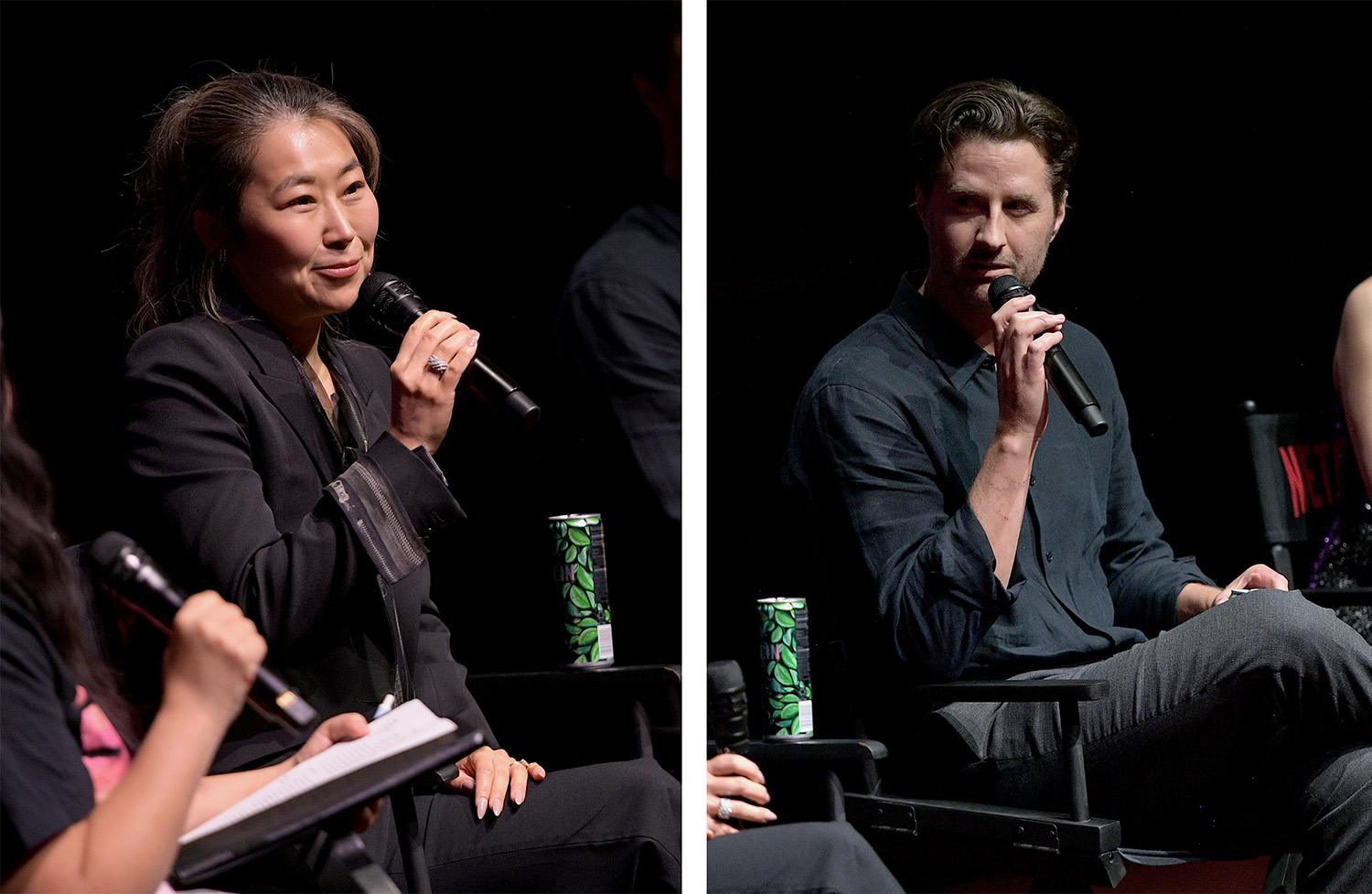
You’ve got to have the right songs before you put all of your time into boarding, so explain how you built the movie around that?
Chris Appelhans: I think it’s a unique challenge to this movie, in that it’s kind of a pop musical but not a conventional musical in any sense that people are singing their feelings in a Broadway sense. The ultimate challenge with this is that pop music, above all, needs to be a bop and it needs to be hooky, and it needs to be irresistible. A movie requires a story. You can’t just have seven random songs in a 90-minute movie; that’s death for an audience. Trying to find this balance of storytelling and pop writing was scary, but we were, like, that’s the only way this works.
Who helped you create those songs and build them as you were also iterating the movie?
Appelhans: We had a couple really important collaborators. The first premise of the film that we had to prove was this idea of music as a superpower; there’s women with voices that can literally move your soul. We found a K-pop songwriter named EJAE who did a few demos for us early on, and I think that was fundamental in getting the greenlight, because we could show cool artwork and do our pitch.
Kang: But, also it needed a soul behind the music. EJAE brought so much soul. And she ultimately became the voice of Rumi in vocals.
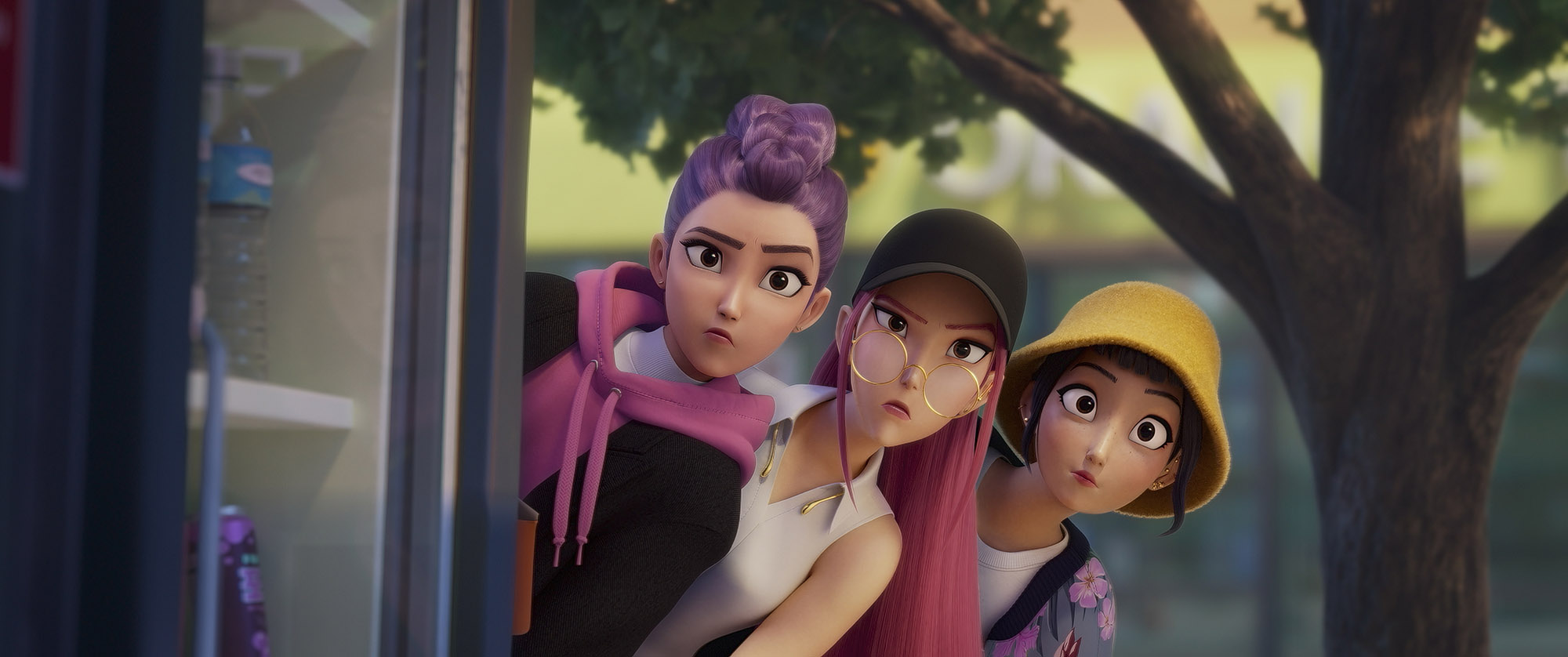
Appelhans: After that, we brought in Ian Eisendrath as executive music producer, and that was the beginning of a huge collaboration with Black Label and a bunch of different songwriters.
Kang: For some of the songs, we did as many iterations, or close to, as on storyboards because you had to. Some of the story keeps changing and we needed some of the lyrics to be a little different, and when you do that the rhythm of it could change. I don’t know if the songwriters were told that from the start. Some of them were like, “What? That’s not how we work in pop music!” But we do an animation!
At a certain point, you have to lock songs so you can get to work boarding and animating without impacting the budget and release window. Was there a cutoff time for song production?
Kang: As directors, you kind of try to ignore the schedule. We had really great producers to keep us on track. We used a lot of temp music. You’re kind of forced to decide on a tempo and once you do that, you can storyboard and figure things out to the beat. I think that helped with a lot of story artists. But a lot of times we were like, “We don’t have a song, but this is kind of the idea so…go!” They actually did an amazing job with it.
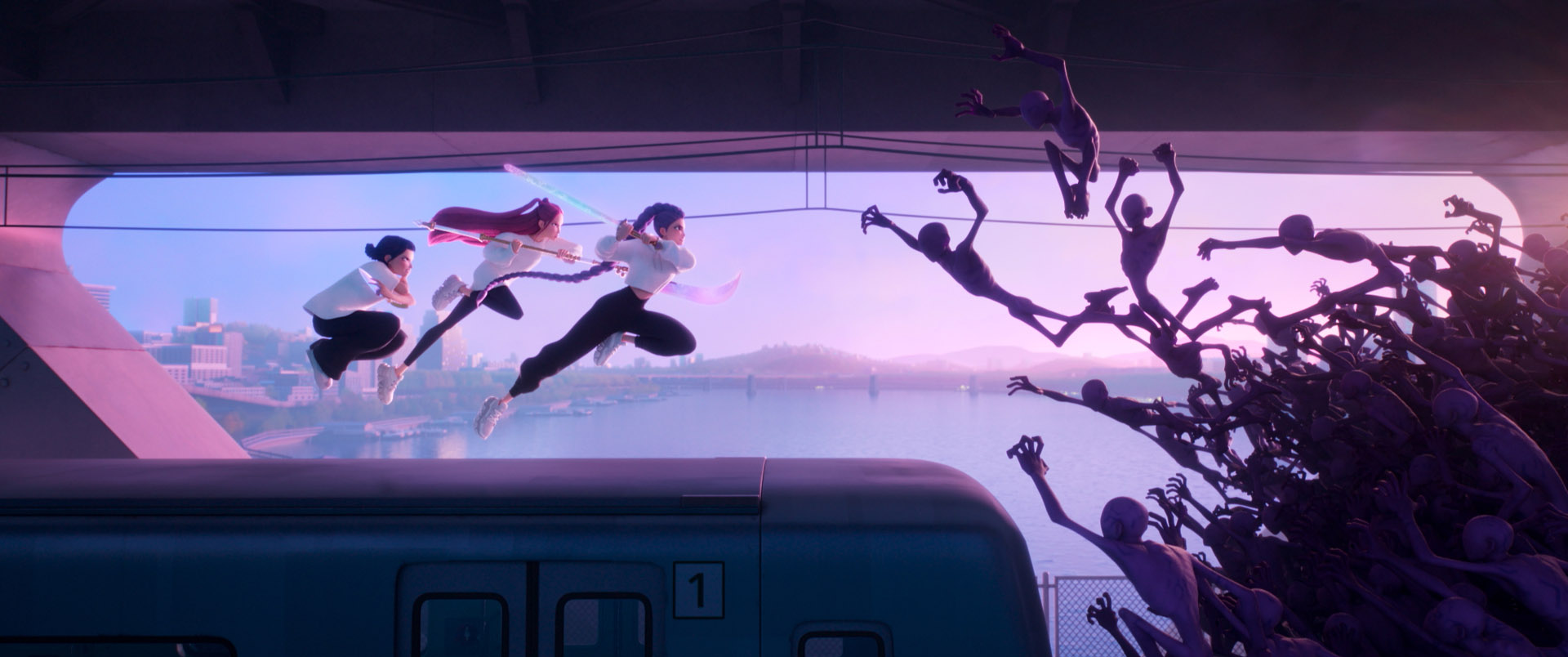
Every song is a set piece that features all kinds of reference from K-dramas to anime and K-pop music video tropes. Was the idea to create a pastiche of things that you both love or your board artists really love about Korean culture?
Kang: There were a lot of things that we referenced and wanted certain moments to just be recognizable. But we also always wanted to subvert it in some way. Like for the “Meet Ugly” scene, which is the meet cute of Rumi and Jinu and when the Saja Boys first show up. In “Meet Ugly,” it starts with that kind of romantic thing, and it feels like it’s gonna go a certain way. Then we pull the rug from under Rumi, and it becomes totally different, which has been done but not in Korean animation. It was actually very difficult to figure out that timing in animation because it’s not real slow-mo. It has this kind of rhythm of slow ins and outs. And a lot of the date scenes, they were inspired by boys and girls and relationships that we wanted to see.
Appelhans: In Maggie’s original mission for the movie that I definitely connected to, there’s this idea of presenting women that were badass, super beautiful, and glamorous. But also weird and funny, food-loving, and silly and wearing their pajama pants. That’s the thing where I’m like, “God, this is so long overdue!” To me, that combination of being fantastically perfect and also very flawed and human is at the heart of a lot of Korean storytelling. Even the K-pop artists themselves often present a pretty awesome combination of, like, “I’m so amazing,” and also, “It’s just me, this humble, slightly embarrassed person that is being given all this attention.” I felt like that informed everything we did with all the characters. We just kept trying to make them kind of fabulous and amazing, but also human and silly and flawed. Even Jinu’s got his funny moments of being a goofball and being awkward and not being cool at all.
Kang: One of my favorite moments is when he almost slips in the bath house before he runs off with the little, “hehe”.
The Huntrix trio do get to run the gamut from extreme anime expressions to the polished glory of their arena shows. What was your approach to connecting the visual halves of a whole with their identities?
Kang: It added to the comedy. But it was really just wanting the girls to feel very real. I’ve made most of those faces. My kid would watch some scenes and say, “That’s mommy and that’s mommy.” It was really to show women the way that I wanted women to be portrayed in movies, especially in a superhero kind of movie. We worked really hard to create mouth shapes and eye shapes that were very Korean. So even though the girls are speaking in English, they were mouth shapes that you would only make as a Korean person, with our Korean language. We worked really hard with animation to achieve that. It was all because we wanted to do this. It was just the story and the characters informed that design.
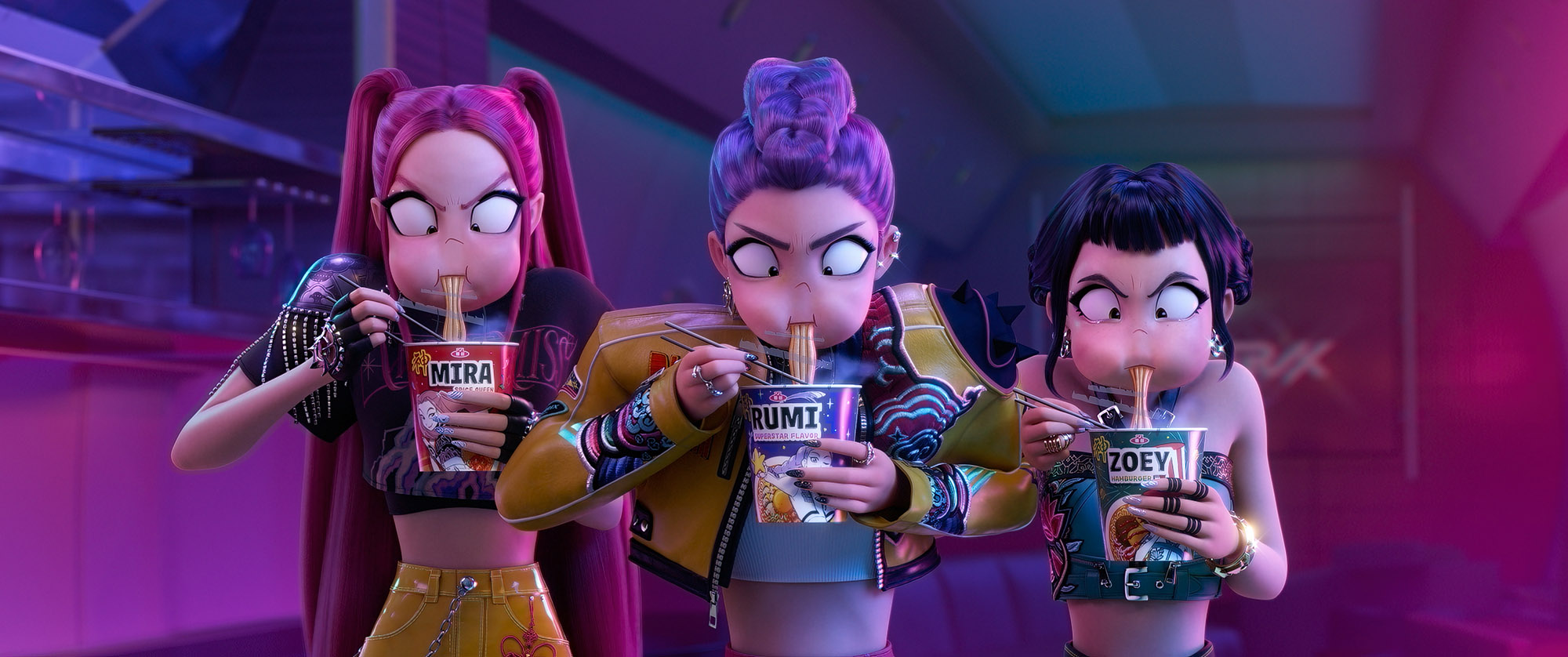
Was there a particular sequence that you labored over the most to get just right because it had an impact on the whole tone and execution of the feature?
Appelhans: Part of our approach, and this is almost like a strategy, is that whatever sequence ends up first in the production order, you put everything into it, whatever it is. In our case, it was this “Meet Ugly” scene, which is a comedy scene and it had some camera work that was an homage to K-drama tropes. But it also had some aspirations for sophisticated lighting and this funny acting and Rumi’s double chin. I think a good sequence usually contains a lot of the DNA of the whole movie in it, not all of it. But I think our approach was, “Let’s just make sure that every sequence comes out great, and that will just raise the bar.” Once you have a great scene, that’s just some people in an alley, and then the next scene is the opening plane fight concert scene. Everyone’s like, “Holy crap! We’ve got to make that really, really good!” You just start with the bar high, and then the talent and the ambitions of our crew always were like, “Okay, fine, then we’re just gonna keep hitting three pointers no matter what you guys throw at us.” I don’t know how else to do it, because once you’ve compromised on a sequence and [it’s] just okay, then it’s tough.
Kang: It was such a hard movie to craft because we had so many pieces. The Jinu story and the girl’s story needed to come together. We had such little screen time really, to work with, if you think about it. Animation stories are so complex, but we don’t get as much time as we do in live action. It was a lot of push and pull. The story, ultimately, just never really changed since we started. But it was really screen time and how much we can overlap [stories], but not have one take over the other. It was a lot of crafting and re-crafting. We couldn’t really be focused on one, or even a few scenes, because every [scene] had to motivate the next one. If we took away from this one, then three of the other ones would be affected. I’ve never worked on a movie like that, and that part of it was very challenging.
In terms of character design, the Huntrix girls and the Saja Boys all go on a visual journey with several looks defining their arc from start to finish. Did you assign them to specific character designers or work on them together?
Kang: With the boys, one artist handled the three looks, costume-wise. When we first see them, we really wanted this bubble gum pop, very saccharine, super sweet look. The middle one is very brief, you see it right before they turn dark. And for the end, I really wanted them to look like the iconic Grim Reaper with the hat which is much more traditional. It has been done in K-pop before, but only because that is a traditional Korean look. We also tried to light them in more of a silhouette, because the hat is such an iconic thing. We just wanted to show the polar opposites of what a boy group could be.
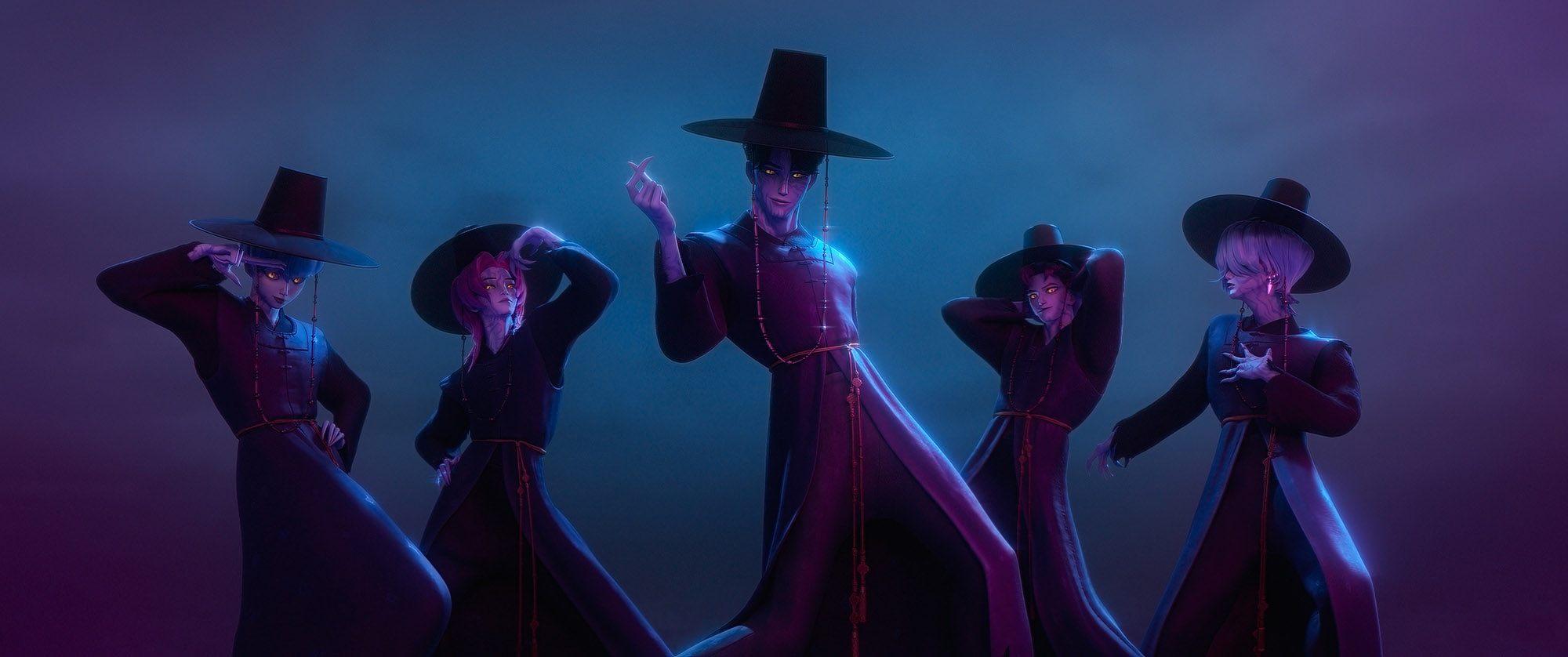
Appelhans: Maggie described in her fandom, like following one type of boy group and having them change up their look, and being like, “Oh….I don’t know how I feel,” so it’s [showing] that kind of authenticity to a personal experience.
The other thing that was really tricky was that the costumes are also plot points. With the girls, for example, with Rumi, there’s the “Golden” song and the gold costumes represent their kind of MacGuffin of a dream that they’re chasing of being perfect and beyond reproach. By the end of the second act, Rumi is standing there and that dream is literally and physically in tatters. It’s shredded around her. The idea that we could service the way that K-pop works, and all the ingredients, but also make it part of this fantasy plot, was really fun. It always felt like, as is often the case with these [films], you’re working for a long time, and then you have this “a-ha!” moment. And then, you’re like, “How did we not think of this? It’s so obvious that this should be that!” But you just have to live in that world until the light bulb goes off.
Speaking of color, there’s a color throughline with the vocal power of the Huntrix trio which is first manifested as golden and then turns into this rainbow look by the end. How did you come to that visual evolution?
Appelhans: There were several epiphanies with the color identity. Helen Chen, who was our production designer for the first half of the show, really helped us crack this. We had the Honmoon [power], and then there’s a thing they’re all reaching for, the Golden Honmoon, which is a bit of a false goal. It’s one color; pure, singular, and perfect. Thematically, there’s this idea that we have more than one dimension to us. There are imperfections and by acknowledging those imperfections, we get closer and maybe form stronger relationships. Helen was really like, “Well, then we can’t have the Honmoon be golden at the end because it doesn’t make sense.” That helped us figure out what we call a Rainbow Honmoon, which is this rainbow, chromatic thing with prismatic colors. It gave us somewhere new to go visually and it just happens to be suitable for editorial music video glamor, fortunately. We could make it look good. It’s kind of theoretical, but I think people feel it.
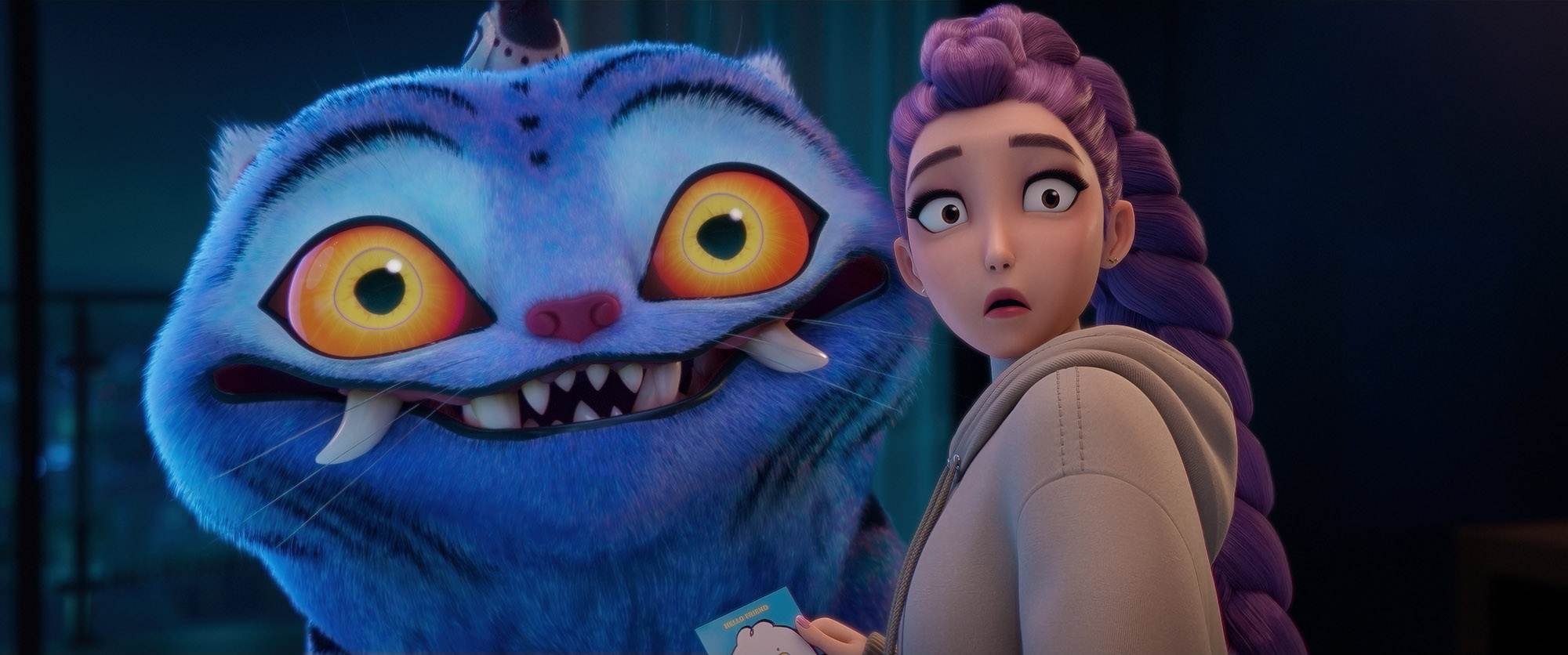
Korean stories often embrace the ultra romantic or the ultra tragic. KPop Demon Hunters lands in the middle. Did you struggle with where to ultimately go with Jinu’s ending?
Kang: We do have a few different endings that we tried out and also tested out. Ultimately, for Jinu’s story it felt right for him to not get everything and be around at the end of the movie. He really needed to listen and learn from Rumi’s message, be inspired by it and sacrifice himself for the better good. He gives his soul to the big battle, and ultimately saves her, but he’s also the catalyst for all the other fans to sing with Rumi. He was the first domino to fall. And he’s the bad guy. He has regrets, but he redeems himself by owning up to it.
Appelhans: I also feel like, when we were talking about it, that great love stories, or great loves tend to really change each other. They change who the other person is. Whether you get to be together at the end of that, I think we judged the relationship less on like, Did they get married, or hold hands? And more on, this girl came into this demon boy’s life and made him redeem himself after a lifetime. He probably wanted to, but it was so buried in him. And vice versa, she learned a lot from him. I feel like Maggie was always really firm about wanting tragedy, but that’s because good tragedy is also super romantic.
Kang: I also just think it’s hotter to have him be this forever, unattainable boy.
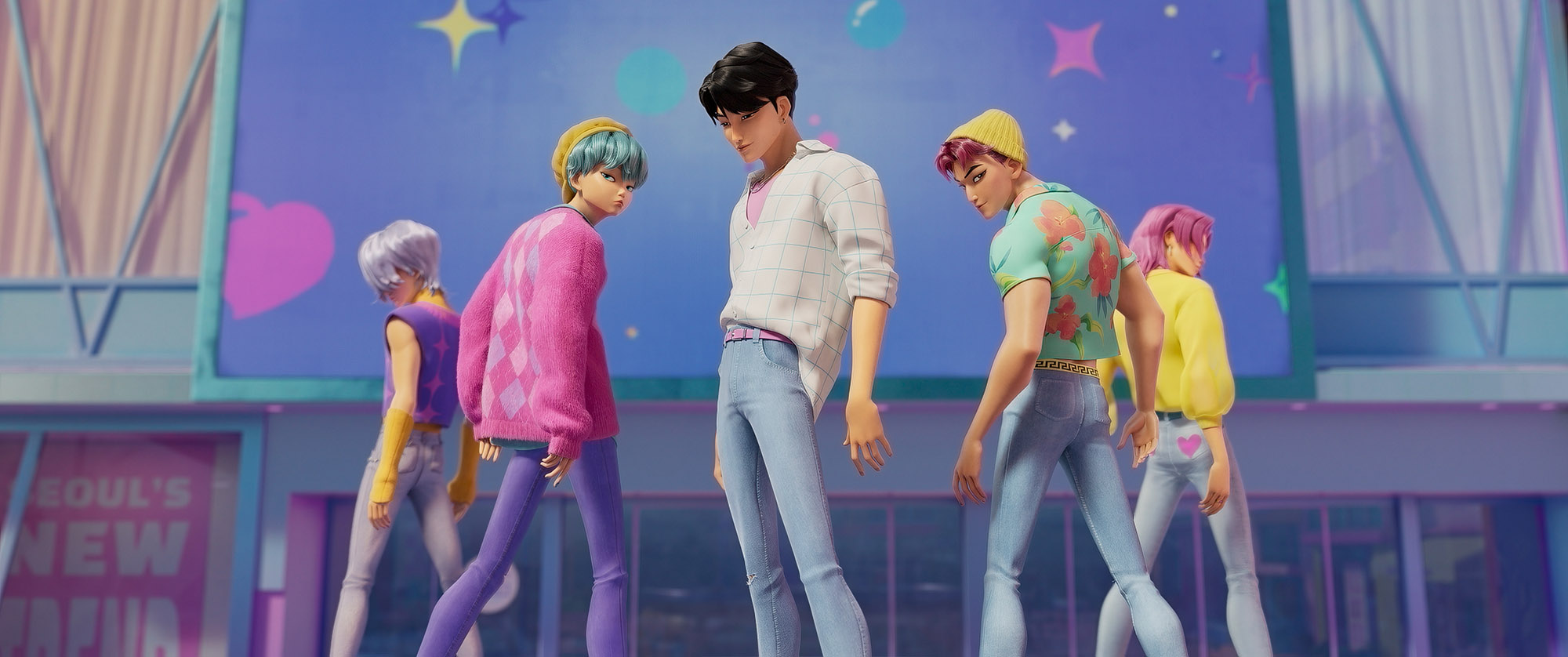
There is a resolution to the Honmoon protection shield from the demons, but there also seems like a lot of mythology left untouched. Did you cut or hold back material that could feed a prequel or sequel?
Kang: I think there’s questions that are a tiny bit answered in the movie, like Rumi’s origins. Who were her parents, her relationship with Celine, Celine’s relationship with Rumi’s mom, there are a lot of things that we had to omit because we were very focused on meeting time with the movie. But also, there’s a lot of things even with the origin stories of the girls, like, how did they become hunters? How were they chosen? We have a whole backstory for all of them and we did board a lot of those scenes. But ultimately, when we cut them [into the edit], the movie just kind of rejected it. It wasn’t that the stories are bad, but this movie is the story of Rumi and her coming to the acceptance of her flaws, so it didn’t really belong. So, there are stories that can be made.
Appelhans: So many stories.
This interview has been edited for length and clarity.
KEY DETAILS
Directors: Maggie Kang, Chris Appelhans
Producer: Michelle L.M. Wong
Screenplay by: Danya Jimenez, Hannah McMechan, Maggie Kang, Chris Appelhans
Story by: Maggie Kang
Executive music producer: Ian Eisendrath
Original score by: Marcelo Zarvos
Production by: Sony Pictures Animation
Cast: Arden Cho, Ahn Hyo-seop, May Hong, Ji-young Yoo, Yunjin Kim, Joel Kim Booster, Liza Koshy, with Daniel Dae Kim, Ken Jeong, Byung Hun Lee
Co-producers: Scott Berri, Jacky Priddle
Original songs written by: Danny Chung, IDO, Vince, KUSH, EJAE, Jenna Andrews, Stephen Kirk, Lindgren, Mark Sonnenblick, Daniel Rojas
Original songs produced by: Teddy Park, 24, IDO, DOMINSUK, Jenna Andrews, Stephen Kirk, Lindgren, Ian Eisendrath
Original songs performed by: Ejae, Audrey Nuna, Rei Ami, Andrew Choi, Danny Chung, Kevin Woo, Samuil Lee, Neckwav, Lea Salonga
Featuring an original song performed by: Jeongyeon, Jihyo, and Chaeyoung of Twice
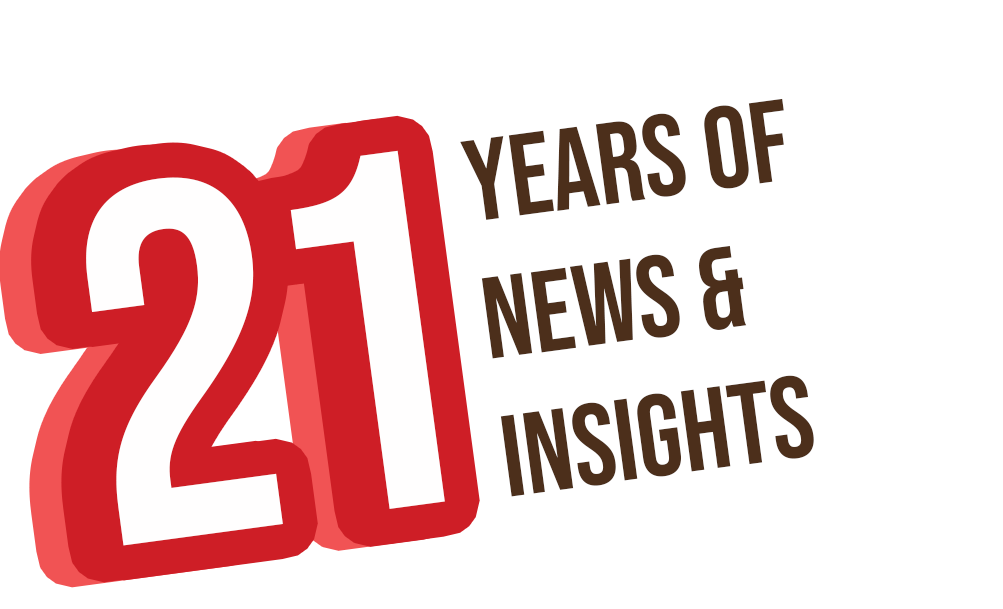
.png)